Selcouth Chronicles Week 23
Hello family and friends! Welcome to week 23 of the Selcouth Chronicles.
Week 23: June 9 - June 15
June 9: Ahrweiler ->🚗 Cologne 🚂 ->Amsterdam
June 13: Amsterdam -> 🚂 Brussels 🚂 -> Brugge
June 15: Brugge -> 🚂 Ghent
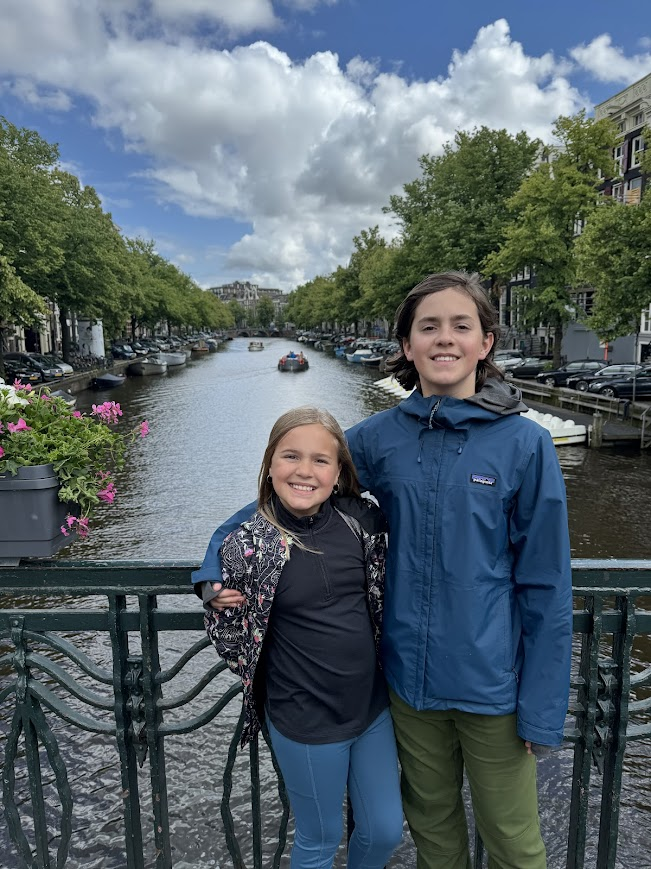
GERMANY, THE NETHERLANDS, AND BELGIUM
Highlights: Cologne Cathedral, Stedelijk Museum, Anne Frank House, gourmet peanut butter, Rijksmuseum, Van Gogh Museum, bicycling in Amsterdam, canal tours in Belgium, Historium, Historic Center of Brugge, Michelangelo’s Madonna and Child, Belgian lace, Belgian fries, Belgian beer, Belgian waffles, Belgian chocolates
James:
We started the week with a ride to Cologne. It was actually just a quick break on our way to Amsterdam, but it was still a very interesting place. Just outside the train station was the Cologne Cathedral, a huge building “painted” nearly black from generations of pollution. The cathedral is famous for housing the remains of the Three Kings. We could see the tomb from the back of the church, but we were unable to go up to the front as it was a Sunday and they were holding services. The interior of the cathedral was beautiful, but by this point I’ve seen so many beautiful places of worship that I was not as impressed as I expected to be - it was the exterior of the building that was the highlight for me.
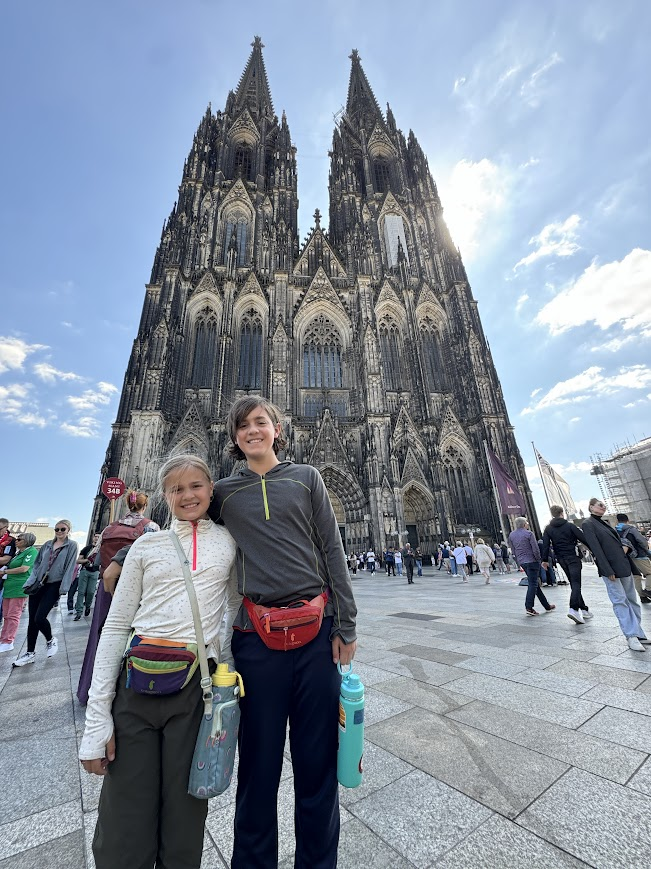
We were scheduled to head back to the train station soon after that, so we grabbed a snack for the road - our first German pretzels! Then we collected our baggage from the ridiculous (but cool) bag deposit and caught our train to the Netherlands. We arrived in Amsterdam in the early evening and checked into our hotel. We went out for a walk and dinner at a poke place, then made our way back through a big square that had some interesting sculptures and a sign that made absolutely sure nobody would dare to pee on the cobblestones.
On Monday we had tickets to visit the Stedelijk Museum, which is a modern art museum. It had some very interesting exhibits, including many well-known artists (Mom kept track as we went along: Mondrian, Chagall, Cezanne, Van Gogh, Kandinsky, Matisse, Picasso, Eames, Ernst, Lichtenstein, and Warhol) and some we had never heard of, like a Romanian artist named Anna Lupas who defied her communist dictators through art. I also really liked their Light Lab Exhibit, where we played with mirrors to create optical illusions and used spinning lights to make our shadows dance on the walls. Surprisingly, when we thought we were done Abby, Mom, and I got absorbed in an interactive project with lentils and rice. Dad had meetings at dinnertime, but the rest of us ate at a yummy Mediterranean restaurant until our stomachs were ready to explode.
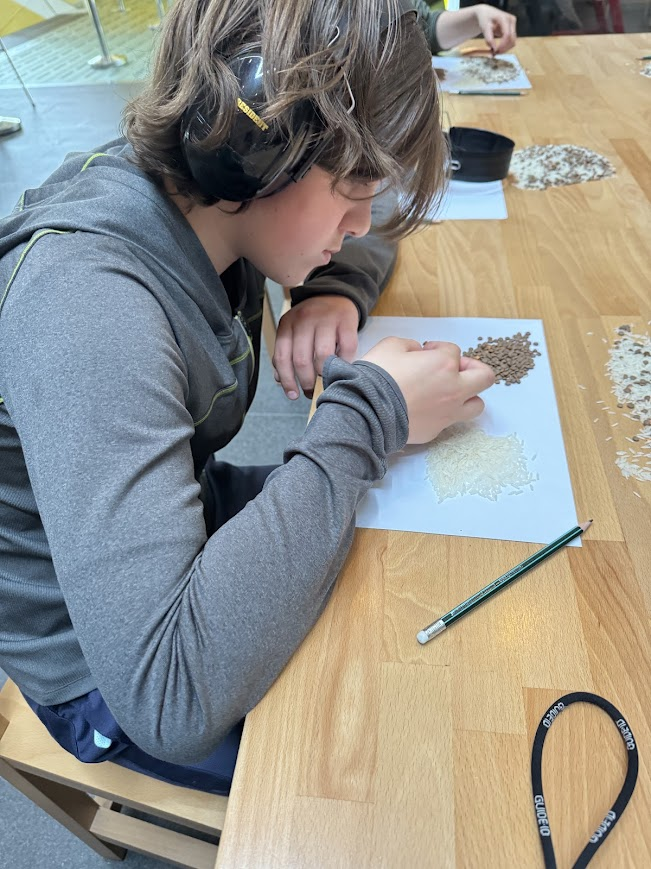
On Tuesday we planned to do a walking tour of the city. On our way to start that, we decided to walk past the Anne Frank House Museum. Mom and Dad had tried to get us tickets earlier, but they were sold out more than a month in advance! By an incredible stroke of luck, Dad checked for tickets one final time and it turned out that there was a last-minute cancellation for a group of six 20 minutes later. We jumped at the chance to get in, bought the tickets, and were able to walk in right past the “SOLD OUT” signs! Abby will write more about the AFHM, but I just want to say that even though I know many of the costs of WWII and have learned about concentration camps, it was still pretty jolting to read about the incredible hardships of her life.
After leaving the Anne Frank House, we livened up our moods with our planned walking tour. It showed us a lot of little gems of the city. Some were part of the tour, like the Hidden Church (aka the de Papegaai Church), the Begijnhof, a flower market, and a WWII memorial. Others, we found ourselves along the way, like a LEGO store and a peanut butter shop! After that, we had an unhealthy but delicious snack of gourmet fries and then burgers for dinner.
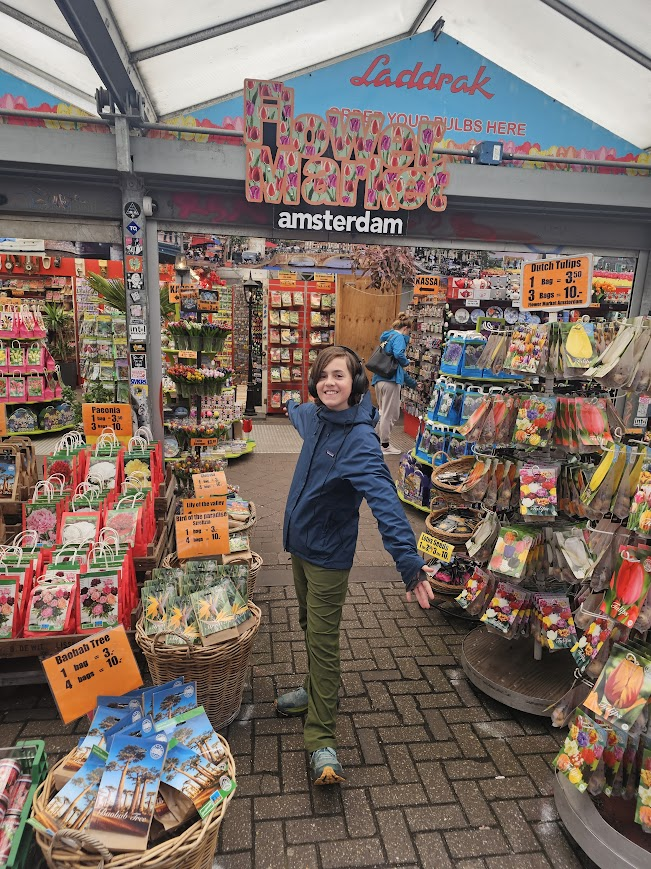
Wednesday began early with Mom, Abby and I going to another museum, the Rijksmuseum, where I broke museum property twice. Don’t worry, I didn’t break any artwork! We were doing a family scavenger hunt, and the special audio unit dropped off the lanyard onto the stairs and stopped working. We went back and exchanged my unit for another one, which lasted for even less time than the first one. I didn’t drop it this time; its electronics just decided to take the day off and the screen froze! It was quite embarrassing having to exchange it again, but luckily the third time was the charm and I didn’t have any problems after that! The Rijksmuseum is massive, and houses everything from swords to ceramics to model battleships to doll houses, not to mention sculptures and paintings. We made sure to see the museum’s famous collection of Rembrandts and Vermeers, but when we had to leave after a few hours we had barely scratched the surface. It really is a big place!
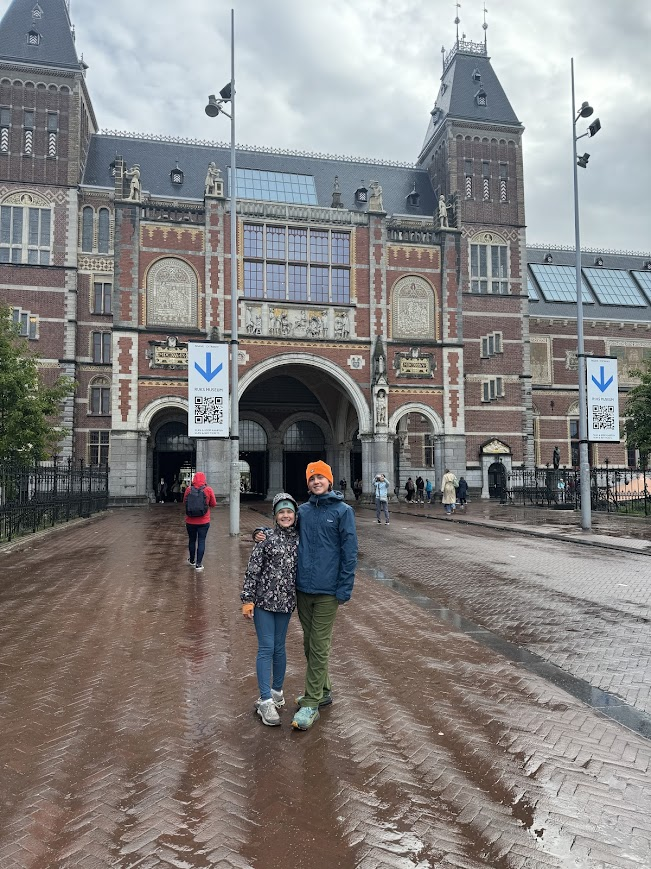
Our morning at the museum was followed by… an afternoon at another museum! We had tickets for the whole family to visit the Van Gogh museum, which tells the story of the famous Dutch painter and houses some of his most famous paintings. I recognized ones like Sunflowers, The Potato Eaters, and The Bedroom. It had some truly interesting stuff. I enjoyed learning about Van Gogh’s motivations, like how he painted common people because he thought that they worked hard and deserved more respect. He thought he was more like the peasants and farmers than the upper class, and I read that he enjoyed working on simple themes because he connected with them. After that, we headed back to the hotel, but Mom said that going to Amsterdam without biking would be a crime. Dad had to work, but the rest of us rented some bikes and went for an hour-long spin around a beautiful park.
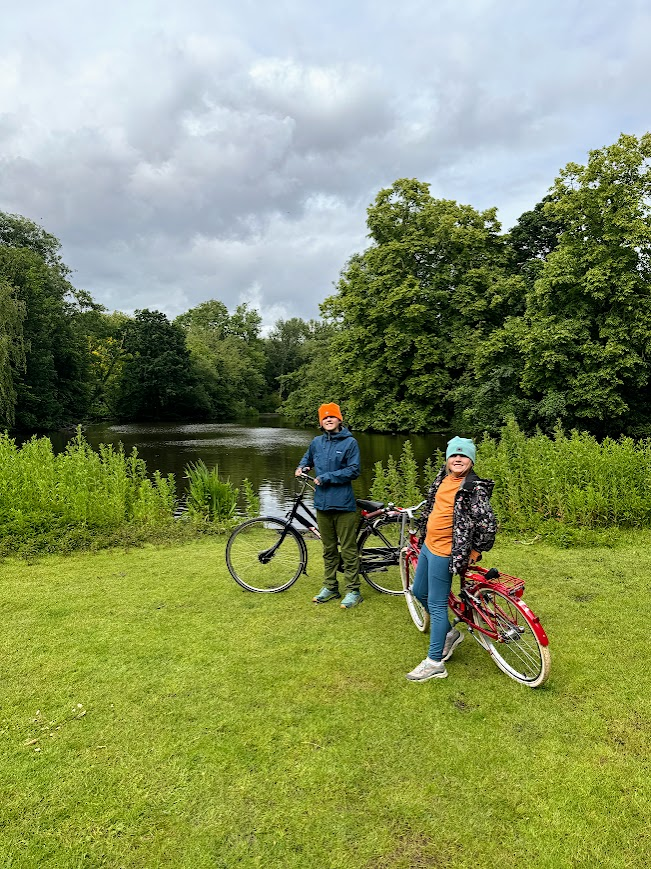
On Thursday we had to take two trains to Brugge, Belgium. It took a very long time thanks to delays in Brussels. By the time we got to our Airbnb and settled in, we only had time and energy for a late dinner and then it was off to bed. On Friday morning, we grabbed some delicious breakfast bagels for fuel before going off to a canal tour. It was very cold that day, so Abby and I got some hot chocolate, in the literal sense. We got it from a chocolate shop that made their hot cocoa by putting hot milk in a cup and giving you a cube of chocolate to melt into the liquid. It was wonderful. After our pretty ride, we met Dad to go to the Historium, a very interactive history museum. Its activities included a VR experience, an immersive movie-like tour, and a climb up a very tall tower for a breathtaking view of the town’s main square.
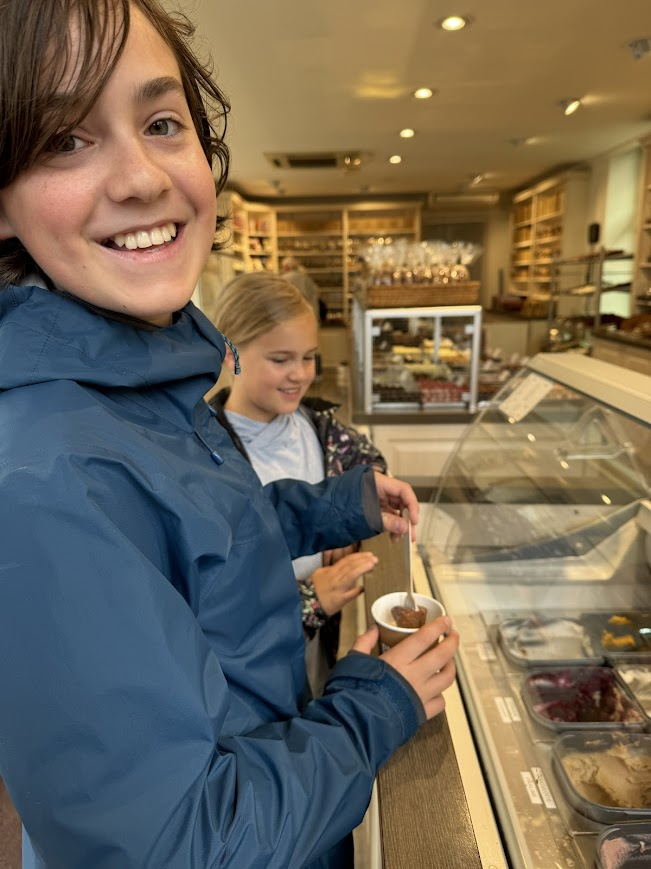
We were very hungry after all of that, so we picked up some cookies for later, and grabbed quiche at a charming little cafe. Really, the quiche was to hold us over for the main event: Belgian waffles! We all got different waffles; I myself picked one that was covered in delicious hot cherries and vanilla ice cream. I made a huge mess of myself but it was incredibly delicious. Finally, we cleaned ourselves off and headed to a shop that sold antique Belgian lace. Afterwards we had dinner at a restaurant by a park and went to bed.
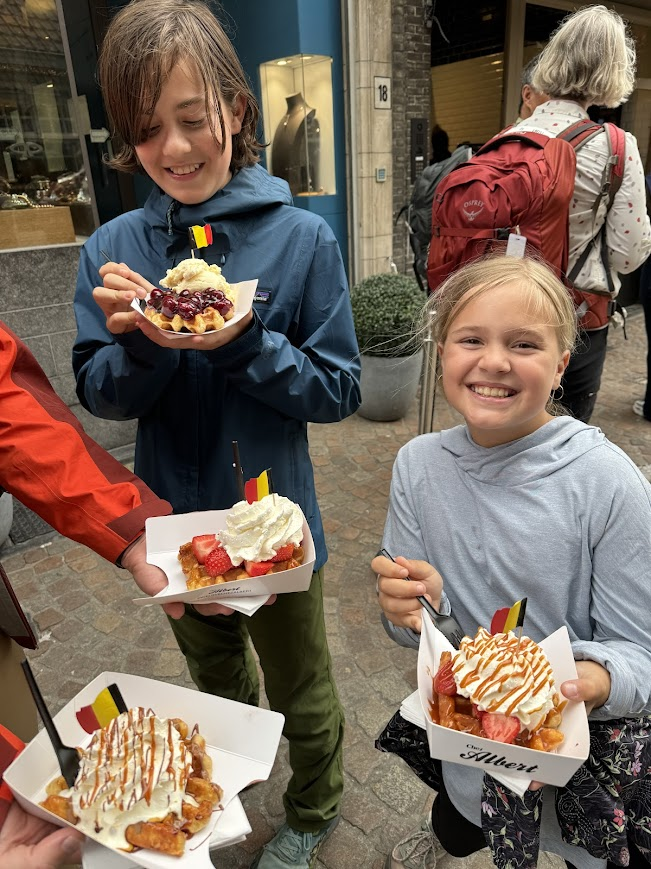
I liked our Friday breakfast so much that I requested that we go back again Saturday morning, and it was just as tasty the second time. Next we visited the Church of Our Lady, which is famous for having Michelangelo’s sculpture Madonna and Child, which was the only sculpture of his to have left Italy during his lifetime. Then we crossed the Boniface Bridge, which is just a pretty pedestrian bridge with a nice view, but it was packed with people. We went on to the Basilica of the Holy Blood, which houses a relic of a cloth piece with Christ’s blood. The Basilica was very cool, but there were many people violating the “no talking” and “no photography” rules, which was sad. Afterwards, we walked more downtown and visited a bookshop and an excellent chocolate shop where we bought two small bags of Belgian chocolates for later. Then we went back to collect our bags and set off on the train to Ghent, our next destination.
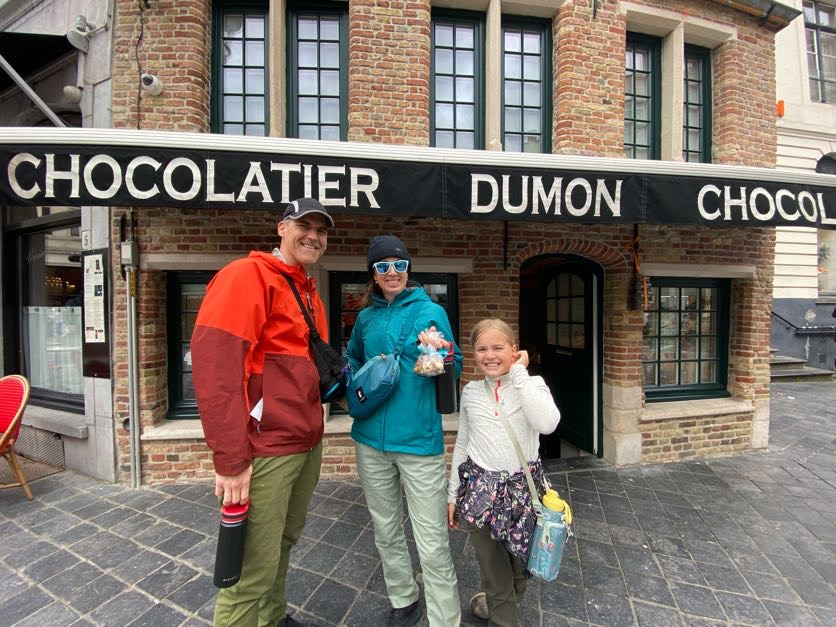
Once we arrived in Ghent we took an Uber to our hotel, the Comic Art Hotel, which was decorated with statues and pictures of different comic-style artwork. We went out for a little walk around town and had dinner at a nice restaurant before going to bed. It was a nice way to end the week, especially once we went back to the hotel and dug into our supply of cookies and chocolates!
Sean:
About a month back I decided to read a biography titled Margaret of Austria: Governor of the Netherlands and Early 16th Century Europe’s Greatest Diplomat. This was as we were approaching our trip to Vienna and I hoped the information would prove useful. The book itself was a fun read, but the web it has weaved through our trip since has been fascinating.
Margaret was the daughter of Maximilian I, who was the Holy Roman Emperor from 1508 until his death. The Holy Roman Emperor was the title created by Charlemagne when he wanted to expand his power and is a major theme in the War of the Bucket video that took us on our journey to Modena. Maximilian was the head of the House of Habsburg and expanded the reach of the Habsburgs through marriage to Mary of Burgundy, Margaret’s mother.
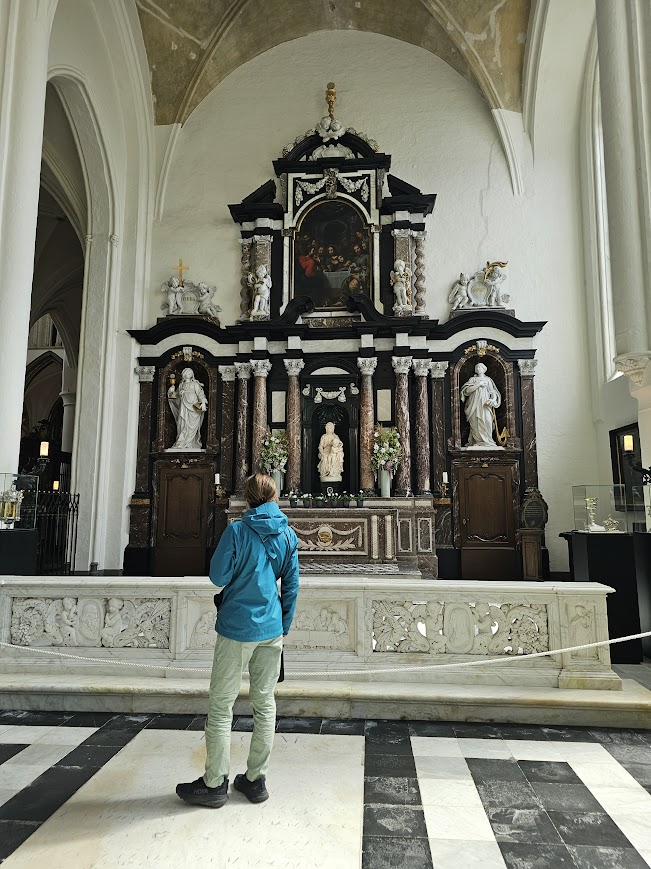
An eventful moment in Margaret’s life was the death of her mother, at the young age of 25, from a fall from her horse. Mary was entombed in the Church of our Lady in Bruges. Mary's father, Charles the Bold, was eventually also moved there to lay with his daughter. On our last morning in Bruges, we paid a visit to the church and saw the very elaborate coffins.
Margaret was unlucky in love, being betrothed at a young age to the King of France. Though she spent years at the court, the King broke off the marriage for political gain. Spurned, Margaret returned home to await the next pairing. To establish an alliance with Spain, Maximilian arranged the marriage of his son, Phillip, to Juana, and married Margaret to their son, John. The wedding occurred, but John died of fever only 6 months later and Margaret had a stillborn daughter a few months after his death. Her third and final attempt at marriage, with Philibert II of Savoy, lasted three years before he died. Margaret is buried with her second husband Philibert in Bourg-en-Bresse, France (perhaps a future journey). The painting at the tomb of her grandfather and mother in Bruges was actually originally commissioned for her tomb.
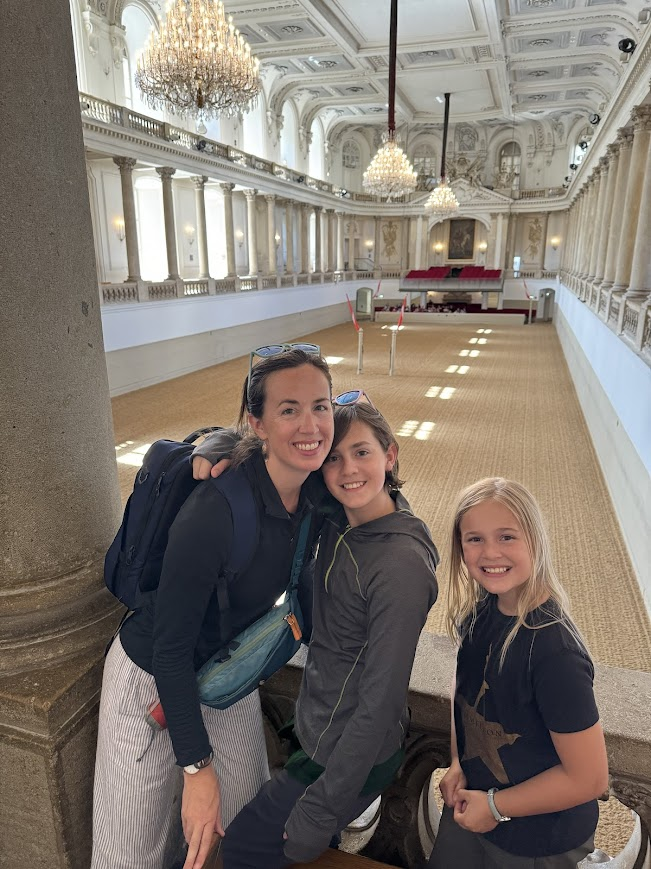
Margaret’s father was a big spender, and was always fighting wars to expand his lands. This required loans, and one city that gave large sums to the emperor was Amsterdam. In return, Maximilian granted the right for the city to put the crown on top of their seal, which to this day can be seen all around the city. Even more loans were taken by Margaret and the Habsburgs in order to ensure that her godson, the first born of Phillip and Juana, was elected as the next Holy Roman Emperor, Charles V. Many years later, descendents of the Habsburg line would lead to Charles VI, the Emperor whose portrait hangs in the Spanish Riding School performance stadium in Vienna to this day.
Our final location of the week was Ghent, where it turns out Charles V was born, and Margaret and Phillip were held hostage when Maximilian had a falling out with the Flanders. Ghent has many similar funny stories sprinkled about, and it was entertaining to have it all connect back to the Habsburgs. Margaret’s story was meant to illuminate a single part of our trip, but now it has become intertwined with so many of the places we’ve seen in Europe. Seeing how many places connect to this story has been a highlight of the last few weeks for me.
Caitlin:
This week was all about canal cities: Amsterdam, Brugge, and Ghent. Of the three, Amsterdam is surely the most well-known to people in the US, but each one has played an important part in early European history, when access to water was of the utmost importance.
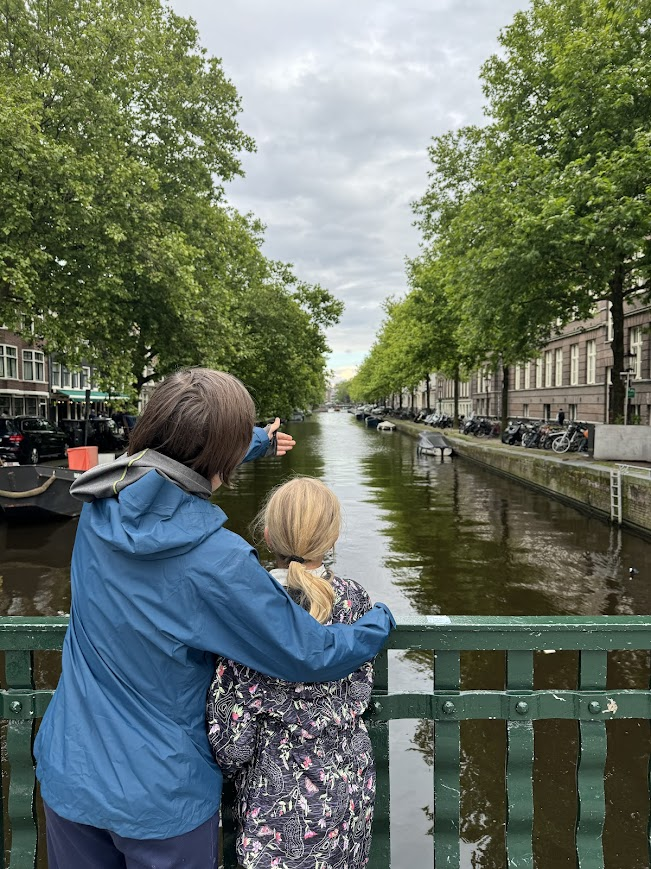
Amsterdam was founded in the mid-1200s. Originally, the canals were created as moats which were used both to control waterways and as a defensive measure for the city. In later years, the moats ended up inside new city walls, thus losing their defensive function. However, by that time growing international trade made the waterways an ideal method for transporting merchandise, and they expanded to become canals. Goods flowed to Amsterdam from the nations of the North Sea, the Baltic Sea, the Atlantic Ocean, and southern Europe via the Rhine River. It’s no wonder that (much like I wrote about Venice a few weeks ago) this small country spread its influence over such a wide swath of world history.
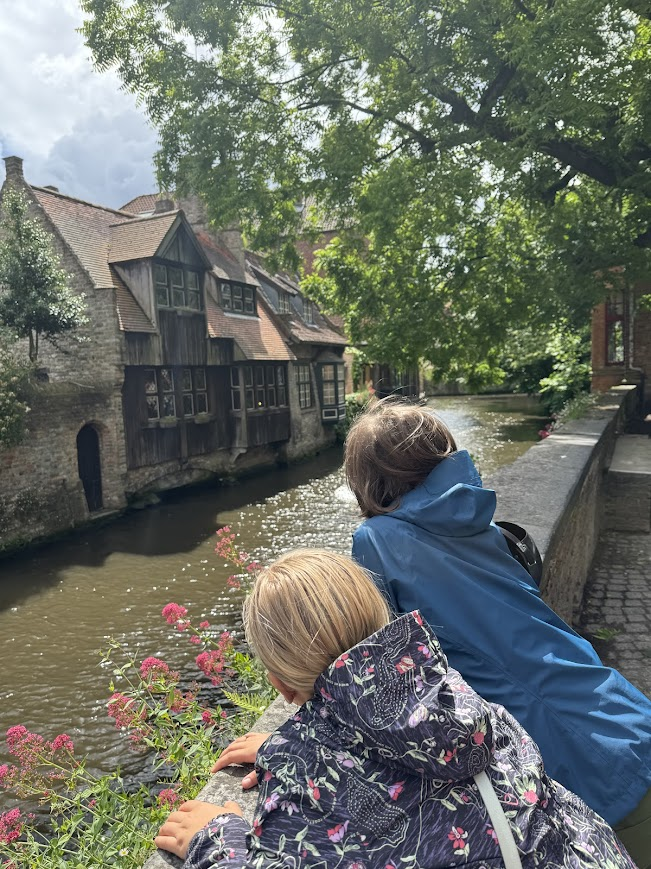
Brugge (I’ll refer to it by the Dutch name; it’s Bruges in English), was our second watery stop of the week. These days it’s a popular tourist area and well known for its picturesque scenery. Its current tranquil appearance makes it easy to forget that this small city was once a powerhouse trade center. Its beginnings were humble, as merely a small settlement in the Roman Empire - there was a small port there as early as the 3rd century CE. By the 11th century, its status as a trade port and producer of fine cloth and luxury goods was growing. By 1500 the population was twice that of London. Around that time, however, the political winds shifted and Antwerp was soon the new center of trade for the Flanders region. A slow decline left the city impoverished by the 1800s, and it wasn’t until the 20th century that it managed to regain its authority as a port city. Brugge managed to escape both World Wars largely unscathed (physically speaking), and thanks to the exceptionally well-preserved historic downtown it is now a UNESCO World Heritage City.
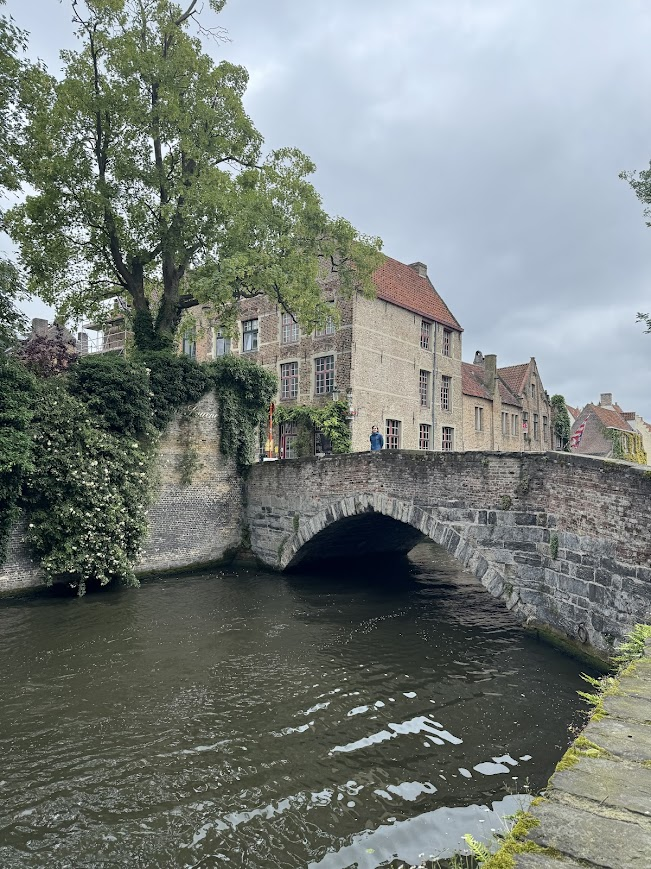
We arrived in Ghent, just a 30 minute train ride from Brugge, on Saturday afternoon. Like Brugge, its canal system helped it rise in status, and in the 1400s it was one of the wealthiest and most powerful cities in Europe. Unlike Brugge, the power of Ghent came from the inhabitants themselves; counts and emperors who took advantage of the convenient canal system to levy taxes on goods and grow their wealth. Boats passing through Ghent were obligated to give a stunning 25% of their grain as a tax to the city. These days the canals (like those in Brugge) are a popular tourist attraction, and they give a sense of what the city was like during its heyday. We are looking forward to learning more about our third canal city in the coming week!
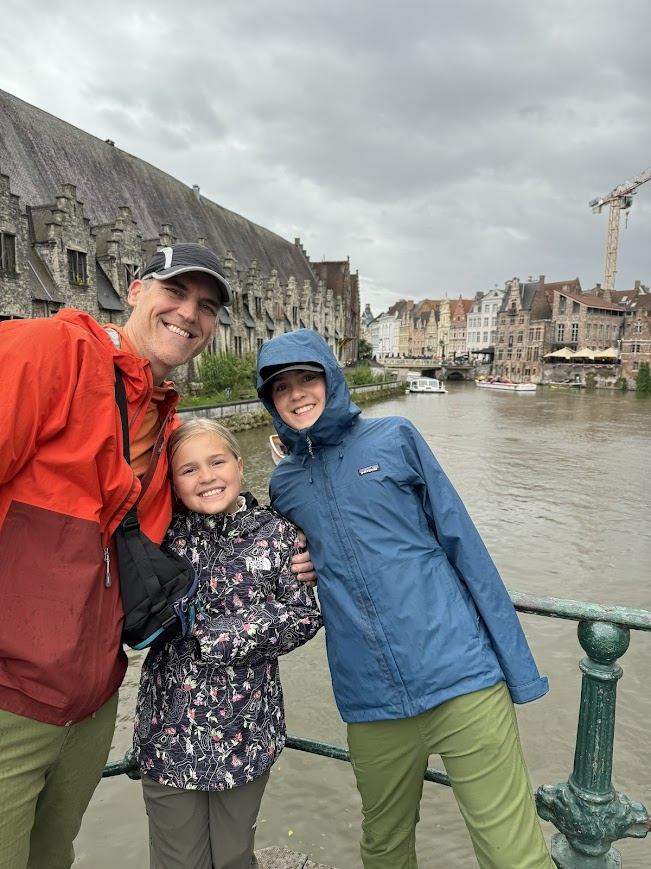
Abby:
Everybody knows who Anne Frank is. She is the young girl who wrote a diary during WWII, and sadly didn’t survive it - but do we really know Anne? This week, we were fortunate to get last minute tickets to the Anne Frank House. They are normally sold out months in advance! We ventured through the office building and Secret Annex, where Anne and seven others hid. It was a very deep and very sad memoir of life in the SA (Secret Annex) and after she was taken by the Nazis. Still, it was a good learning experience because James and I have never read her diary.
Anne was born on June 12, 1929. She lived in Frankfurt, Germany, until she was almost 5 years old. Her father, Otto, wanted to move his company and his family to the Netherlands because Hitler was coming to power in Germany and it was not safe for them to be there. She had to learn a whole new language (Dutch) and make new friends in Amsterdam. Sadly, the move wasn’t far enough to get away from the clutches of the Nazis for long. The Germans invaded the Netherlands in 1940.
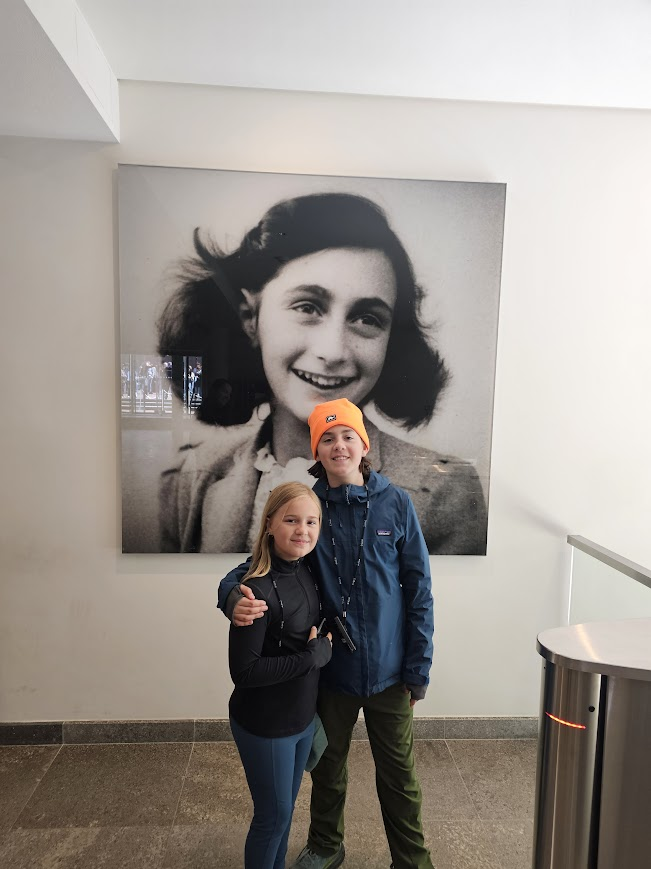
In July of 1942, Anne’s older sister Margot got a letter from the Nazis saying that she had to go work in a labor camp. The Franks obviously did not want this to happen to Margot, so they moved into hiding that Otto Frank had been making. It was called the Secret Annex, and it was hidden above Otto’s office. They were later joined by the Van Pels family of three people and a dentist named Fritz Pfeffer. In her diary, Anne gave the other families different last names so that if anyone found her diary they wouldn’t know who was hiding with her. When she was in the Annex, they couldn’t look out the windows, because if anyone saw them they'd be in a lot of trouble. During the day, they couldn’t walk around, they had to whisper, and they couldn’t even flush the toilet because the workers downstairs might be able to hear them.
On August 4, 1944, after two years of hiding, the Nazi police stormed the annex and arrested all eight people in hiding. Historians still do not know who betrayed the Franks, the Van Pels, and Mr. Pferrer. They were all sent to Auschwitz-Birkenau concentration camp. It was the very last train to go there, and it makes me sad to know that they were so close to being free. Anne and Margot were sent to a different concentration camp (Bergen Belsen) later, where they both died in March of 1945 of typhoid fever. The camp was liberated only weeks after their deaths. The only survivor of the concentration camps of the eight was Otto Frank, who was devastated to learn that his whole family had died. He published Anne’s diary to show the world his daughter’s story.
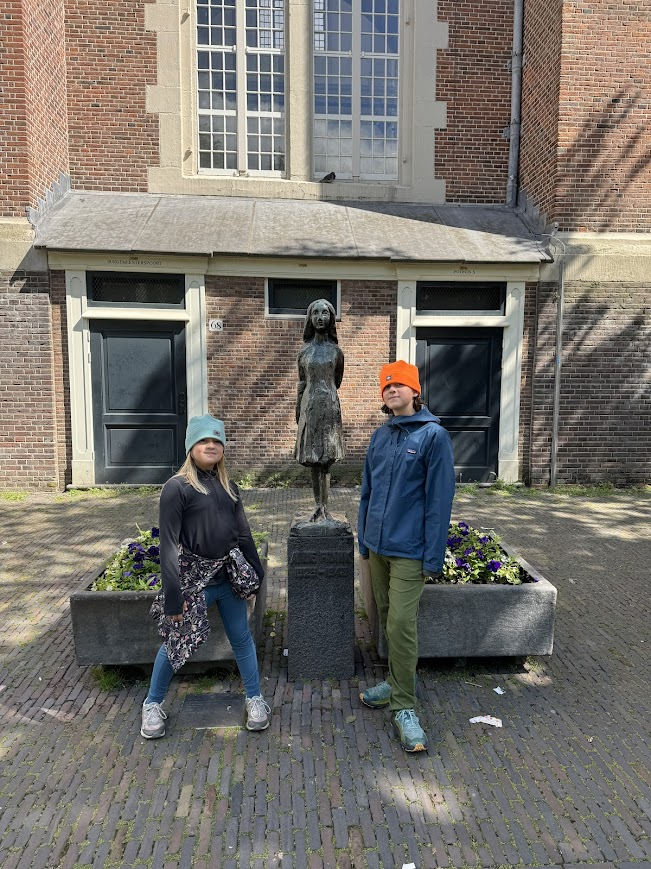
I think that things like World War II and Anne Frank’s story should never have happened. It is upsetting to know that a girl a lot like me had to go through such constant fear and suffering. I hope her story teaches people to have more empathy for their fellow humans.
See you next week!
Sean, Caitlin, James, and Abby
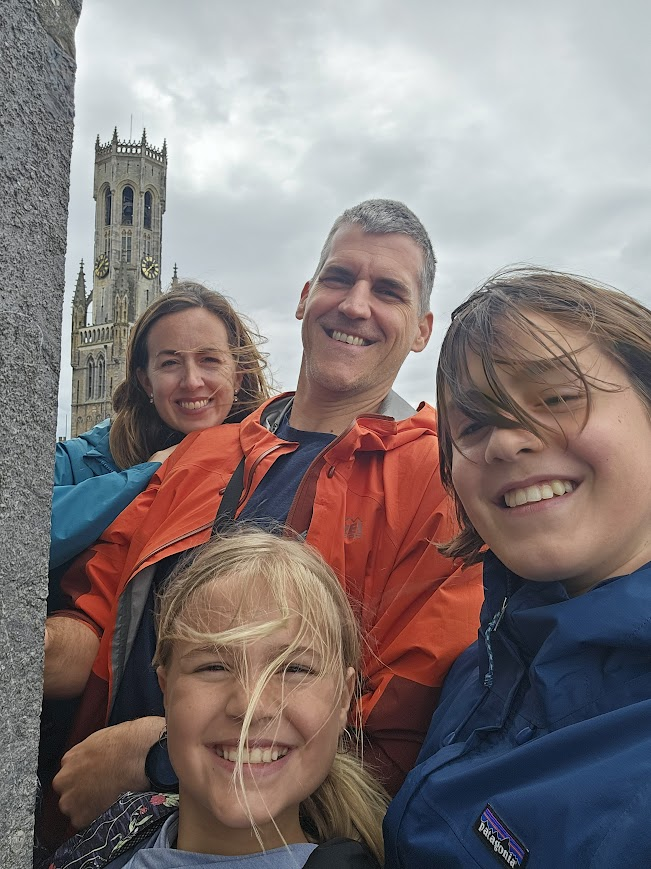
Catching up? Read week 1, 2, 3, 4, 5, 6, 7, 8, 9, 10, 11, 12, 13, 14, 15, 16, 17, 18, 19, 20, 21, or 22.